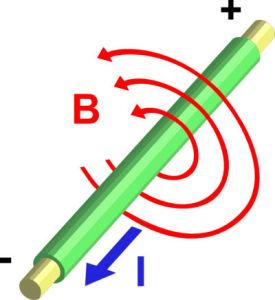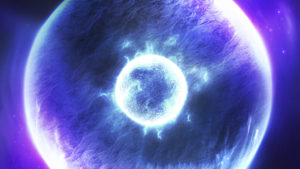The Simplified Case for Cosmic Electrodynamics
06/30/08
Astronomers have implicated a strong role for magnetic fields in many astrophysical processes, yet they appear to be at a loss to explain those magnetic fields or why they should be important. Working within a gravity-dominated paradigm does not help the situation either.
In a recent exegesis submitted to the citizen-powered news site Now Public, a case was made for considering the role of electrodynamics (the movement of charged particles) in astronomy and cosmology. Herein that case is to be made simpler.
The essence of the issue lies in the treatment of magnetic fields by astronomers without reference to any treatment of the underlying electric currents. This seems to be in part due to their use of "new physics" du jour "frozen-in field lines" in plasma and "magnetic reconnection".
Simply put, those concepts may be (and likely are) erroneous.

Electric current produces a magnetic field. The magnetic field can be visualized as a pattern of circular field lines surrounding the [conductor].
Image Credit: Wikipedia / User:Wapcaplet / User:Stannered
Nobel prize-winning plasma physicist (and "father of magnetohydrodynamics") Hannes Alfvén has strongly argued against both the "frozen-in field lines" concept (which he more-or-less invented and popularized before realizing he was in error and imploring astronomers and physicists to ignore his incorrect pseudopedagogical concept) and the concept of "magnetic reconnection" (which he simply referred to as pseudo-science). His thoughts are summarized in one or more peer-reviewed paper(s) he has written on the subject.
More recently, Don Scott has published a peer-reviewed paper also refuting "magnetic reconnection".
If Alfvén and Scott are correct and these two concepts are incorrect, what are we then left with? As it should be, we are left with little more than the definitions of magnetic fields and electric currents as well as the relationship between the two.
A brief survey of definitions turns up several sites in relative agreement.
The HyperPhysics site defines magnetic fields thus:
Magnetic fields are produced by electric currents , which can be macroscopic currents in wires, or microscopic currents associated with electrons in atomic orbits.
One of NASA’s educational web sites offers the following about magnetic fields:
People not familiar with magnetism often view it as a somewhat mysterious property of specially treated iron or steel.
[…]
It is all related to electricity.
[…]
Close to 1800 it was found that when the ends of a chemical "battery" were connected by a metal wire, a steady stream of electric charges flowed in that wire and heated it. That flow became known as an electric current. In a simplified view, what happens is that electrons hop from atom to atom in the metal.
In 1821 Hans Christian Oersted in Denmark found, unexpectedly, that such an electric current caused a compass needle to move. An electric current produced a magnetic force!
Andre-Marie Ampere in France soon unraveled the meaning. The fundamental nature of magnetism was not associated with magnetic poles or iron magnets, but with electric currents. The magnetic force was basically a force between electric currents (figure below):
--Two parallel currents in the same direction attract each other. --Two parallel currents in opposite directions repel each other.
[…]
--Two circular currents in the same direction attract each other. --Two circular currents in opposite directions repel each other.
The World Health Organization defines the electromagnetic field thus:
Electric fields are created by differences in voltage: the higher the voltage, the stronger will be the resultant field. Magnetic fields are created when electric current flows: the greater the current, the stronger the magnetic field. An electric field will exist even when there is no current flowing. If current does flow, the strength of the magnetic field will vary with power consumption but the electric field strength will be constant. - Electromagnetic fields published by the WHO Regional Office for Europe in 1999 (Local authorities, health and environment briefing pamphlet series; 32).
[Italics added.]
Wikipedia defines the electromagnetic field thus:
The electromagnetic field is a physical field produced by electrically charged objects. It affects the behavior of charged objects in the vicinity of the field.
[…]
The field can be viewed as the combination of an electric field and a magnetic field. The electric field is produced by stationary charges, and the magnetic field by moving charges (currents); these two are often described as the sources of the field. The way in which charges and currents interact with the electromagnetic field is described by Maxwell's equations and the Lorentz force law.
The definitions appear to be quite explicit.
The electric field is derived from the collective stationary charges on one or more charged particles themselves (electrostatics). The magnetic field is derived from the motion of charged particles in an electric current (electrodynamics).
From the definitions it appears to proceed logically that, due to the relationship between electric currents and magnetism, we should be able to work backwards or forwards depending on what we observe.
In fact, the Wikipedia article on electric current states:
Electric current produces a magnetic field. The magnetic field can be visualized as a pattern of circular field lines surrounding the wire.
Electric current can be directly measured with a galvanometer, but this method involves breaking the circuit, which is sometimes inconvenient. Current can also be measured without breaking the circuit by detecting the magnetic field associated with the current. [Emphasis added]
If we observe an electric current, we should understand that a magnetic field is generated proportional to the strength of the current. Likewise, where we see a magnetic field we should understand that it derives from the underlying motion of charged particles and that its strength derives from the strength of the underlying current.
The implications are simple yet far-reaching.
Magnetic fields have been strongly implicated in everything from star formation to black holes’ jets, the structure and evolution of galaxies and galaxy clusters.
If magnetic fields are held at least partially responsible for the structure and function of the universe, then by extension electric currents are equally important in the structure and function of the universe. If the universe and galaxies are threaded by magnetic fields, then they are equally threaded by the electric currents from which the magnetic fields arise.
If that be so, then the universe in which we live is truly electric.
Michael Gmirkin
Permalink to this article.
Public comment may be made on this article on the
Thunderbolts Forum/Thunderblogs (free membership required).
The Plasma Universe of Hannes Alfvén
Editor’s note: the following article has just been published in the October-December issue of Edge Science.
In the 20th century no scientist added more to our knowledge of electromagnetism in space than Hannes Alfvén (1908–1995). His insights changed the picture of the universe, revealing the profound effects of charged particle movement at all scales of observation. But recognition never came quickly, and never easily, and mainstream journals typically regarded Alfvén as an outsider, often rejecting his submissions. In retrospect, Alfvén’s difficulties in gaining acceptance can only highlight the inertia of institutionalized ideas in the sciences, reminding us of the obstacles faced by all of history’s great scientific innovators.
Awarded the Nobel Prize in 1970 for his contribution to physics, Alfvén emerged as a towering critic of directions in astronomy, cosmology, and astrophysics. Though he was surely not correct on everything he proposed, decades of space exploration eventually confirmed a lifetime of observations and hypotheses, often with implications that many space scientists did not want to hear. “In the world of specialized science,” wrote plasma scientist Anthony Peratt, “Alfvén was an enigma. Regarded as a heretic by many physicists, Alfvén made contributions to physics that today are being applied in the development of particle beam accelerators, controlled thermonuclear fusion, hypersonic flight, rocket propulsion, and the braking of reentering space vehicles.”1
But Alfvén’s impact reached far beyond new technologies. He devoted much of his life to the study of plasma, a highly conductive, elementary form of matter characterized by the presence of freely moving charged particles, not just electrically neutral atoms. Normal gases become plasma through heating and partial ionization as some percentage of the atoms give up one or more of their constituent electrons. Often called “the fourth state of matter” after solids, liquids, and gases, plasma is now known to constitute well over 99 percent of the observed universe.
Alfven is the acknowledged father of “plasma cosmology,” a new way of seeing formative processes in the heavens. Proponents of plasma cosmology suggest that vast but invisible electric currents play a fundamental role in organizing cosmic structure, from galaxies and galactic clusters down to stars and planets. The Big Bang hypothesis, black holes, dark matter, and dark energy are only a few of today’s popular cosmological themes disputed by scientists working with this new perspective. Many central tenets of plasma cosmology emerged from laboratory experiments with plasma and electric discharge, and it was Alfvén himself who showed that plasma behavior in the laboratory can be scaled up to galactic dimensions: vast regions of plasma in space behave similary to plasma on earth.
Underscoring the enormity of ignoring cosmic electromagnetic effects in cosmology is the fact that the electric force between charged particles is some 39 orders of magnitude (a thousand trillion trillion trillion) times stronger than the gravitational force. In comparative terms, gravity is incomprehensibly weak; a hand-held magnet will raise a small metallic sphere against the entire gravity of the Earth.
Alfvén’s documentation of laboratory plasma experiments eventually made it impossible to ignore the role of electricity in space. He explained the auroras based on the work of his predecessor Kristian Birkeland; correctly described the Van Allen radiation belts; identified previously unrecognized electromagnetic attributes of Earth’s magnetosphere; explained the structure of comet tails; and much more.



